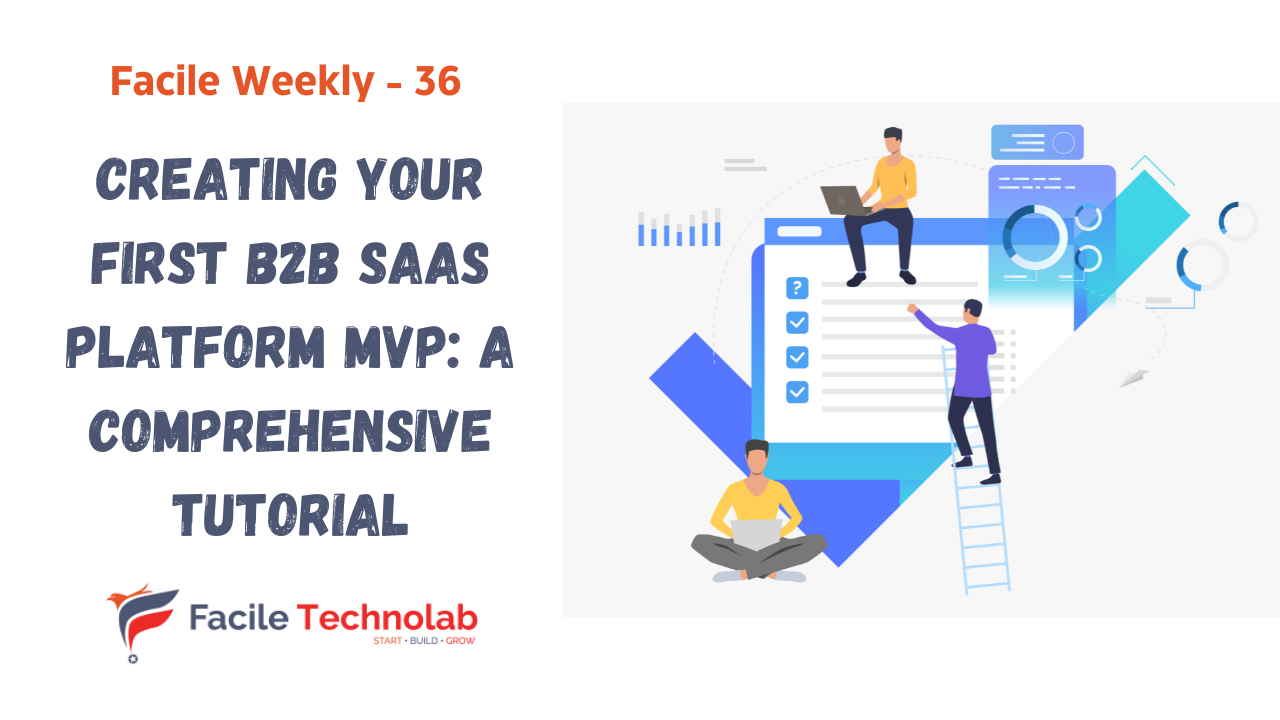Creating Your First B2B SaaS Platform MVP: A Comprehensive Tutorial
 Facile Technolab
Facile Technolab
Embarking on the journey to build your inaugural B2B SaaS Platform MVP? Dive into our comprehensive tutorial, demystifying the process step by step. From ideation to deployment, we'll guide you in crafting a minimal viable product that resonates with your target audience.
The ability to create a scalable software solution that solves real problems for businesses and generates recurring revenue is a compelling proposition. It starts when you've identified a pain point in some industry or stumbled upon a gap in the market begging to be filled.
Whatever is your inspiration, transforming your vision into a B2B SaaS platform requires a strategic approach, and the journey often begins with a Minimum Viable Product (MVP).
This comprehensive tutorial will equip you with the essential knowledge and steps to create a compelling B2B SaaS MVP, the cornerstone of validating your product concept and attracting early adopters.
1. Define the Problem to Solve
The foundation of any successful B2B SaaS platform rests on a deep understanding of the problem space. That's where you become the champion for your target audience. Conduct thorough market research to identify the specific pain points faced by businesses within your chosen niche.
Conduct User Interviews: Talk directly to potential customers. Understand their daily struggles, workflows, and frustrations. What tasks are time-consuming? What inefficiencies are hindering their success?
Analyze Industry Trends: Research current market trends, competitor offerings, and emerging technologies. Are there any unmet needs or untapped opportunities? Statistics show that 42% of new SaaS products fail due to a lack of market need. By validating the problem you aim to solve, you significantly increase your chances of building a solution that resonates with the market.
By clearly defining the problem and its impact, you establish the core value proposition of your MVP and lay the groundwork for a solution that truly resonates with your target audience.
2. Identify Your Target Audience
With a firm grasp of the problem you're solving, it's time to define precisely who will benefit most from your solution. Your target audience is the specific group of businesses whose needs your B2B SaaS platform directly addresses.
Create Buyer Personas: Develop detailed profiles of your ideal customers. Include demographics, business size, industry, roles within the organization, and their specific challenges.
Segment Your Market: Categorize your target audience based on shared characteristics and pain points. This allows you to tailor your messaging and value proposition to resonate with different segments within your overall market.
Understanding your target audience goes beyond demographics; it's about empathizing with their unique challenges and aspirations. By crafting detailed buyer personas and segmenting your market, you ensure your MVP speaks directly to the specific needs of the businesses you aim to serve. This targeted approach significantly increases the likelihood of early adoption and valuable user feedback.
3. Prioritize Core Features for Your MVP
Now that you understand the problem and your target audience, it's time to translate that knowledge into actionable steps. This is where you define the core functionalities that will form the backbone of your MVP.
Focus on the "Must-Haves": Resist the urge to cram everything into your initial version. Prioritize features that directly address the core problem and deliver the essence of your solution. Remember, the goal here is to validate your concept, not build a comprehensive product suite.
Think "Minimum Viable Product," not "Minimum Lovable Product": While a user-friendly interface is important, prioritize functionality over aesthetics at this stage. You can refine the design and user experience in subsequent iterations based on user feedback.
Here's a helpful rule of thumb: 80% of your efforts should be directed towards solving the core problem, and 20% on building a functional and user-friendly experience. By adhering to this principle, you can efficiently develop a focused MVP that effectively validates your concept without unnecessary bells and whistles.
Remember, successful B2B SaaS platforms often evolve from humble beginnings. Focusing on core functionalities in your MVP allows you to gather valuable user feedback, iterate effectively, and ultimately build a solution that truly meets the evolving needs of your target audience.
4. Choose the Right Development Approach
With your core features defined, you need to determine the most efficient and cost-effective approach to develop your MVP. This decision hinges on factors like your technical expertise, budget, and desired timeline.
In-House Development: Building your MVP in-house requires a skilled development team with expertise in relevant technologies. This approach offers greater control over the development process but can be time-consuming and resource-intensive, especially for first-time founders.
Freelancers: Hiring freelance developers allows you to access a wider talent pool and potentially achieve cost-effectiveness. However, managing multiple freelancers can be challenging, and ensuring consistent quality requires careful vetting and clear communication.
SaaS Development Agencies: Partnering with an experienced SaaS development agency offers access to specialized expertise, established development processes, and potentially faster time-to-market. This option often comes with a higher cost compared to freelance work but can be a good fit for founders seeking guidance and a streamlined development experience.
There's no single "right" answer when it comes to development approaches. Carefully assess your resources, strengths, and budget to make the best decision for your specific needs. Remember, the goal here is to build a functional MVP that validates your concept efficiently, and choosing the right development path will significantly impact your success.
5. Launch, Gather Feedback, and Iterate
With your MVP developed and deployed, it's time to showcase your creation to the world! Launching your MVP, however, marks not the end, but rather the beginning of your journey. Here's where the true learning and refinement begin:
Gather User Feedback: Encourage early adopters to provide honest feedback on their experience. Utilize surveys, conduct interviews, and actively engage with your users to understand their pain points, suggestions, and areas for improvement.
Embrace the Iterate-Adapt-Improve Cycle: Analyze the collected feedback and prioritize functionalities for further development. Remember, your MVP is a living document, not a finished product. Be prepared to iterate and adapt based on user insights to ensure your B2B SaaS platform evolves to meet the ever-changing needs of your target audience.
Statistics show that only 0.01% of startups achieve product-market fit with their initial offering. The iterative process fueled by user feedback is crucial for refining your MVP and ultimately building a B2B SaaS platform that gains lasting traction in the market. By embracing continuous improvement and actively listening to your users, you position your solution for sustainable growth and success.
6. Additional Considerations for Success
While the previous steps provide a solid foundation for building your B2B SaaS platform MVP, here are some additional considerations to keep in mind:
Marketing and Sales Strategy: While your MVP is in its initial stages, begin crafting a marketing and sales strategy to generate awareness and attract potential customers.
Pricing Strategy: Developing a pricing model that aligns with the value proposition of your MVP and resonates with your target audience is crucial. Consider offering freemium models or limited-time introductory pricing to attract early adopters.
Security and Scalability: Even at the MVP stage, prioritize security measures to protect user data and ensure the scalability of your platform to accommodate future growth.
Building a successful B2B SaaS platform requires a dedication to continuous learning, adaptation, and refinement. By following these steps, leveraging valuable user feedback, and staying informed about industry trends, you'll be well on your way to transforming your vision into a thriving B2B solution that empowers businesses and delivers exceptional value. Remember, the journey is just as important as the destination, so embrace the challenges, celebrate the milestones, and enjoy the process of building something remarkable.
Conclusion
The journey of creating a valuable B2B SaaS solution is an exciting one, but it can also be complex. As you navigate the initial stages of development, crucial aspects like marketing, sales, and securing funding demand your attention.
Wouldn't it be convenient to have a trusted partner by your side, handling the intricacies of B2B SaaS development with expertise and efficiency? At Facile Technolab, that's exactly what we offer.
With over 8 years of experience and a proven track record of delivering 10+ successful SaaS solutions across diverse industries, we understand the unique challenges and opportunities that lie at the heart of B2B SaaS development.
Our team of skilled developers, designers, and strategists are adept at translating your vision into a robust, user-centric platform, while adhering to industry best practices and security standards.
By partnering with Facile Technolab, you can free yourself to focus on core business activities like securing funding, building your brand, and establishing strategic partnerships. We'll handle the entire development process, from conceptualization and MVP development to ongoing maintenance and support.
Ready to transform your B2B SaaS dream into reality? Contact Facile Technolab today for a free consultation and let's discuss how we can empower your business to thrive in the ever-evolving landscape of B2B solutions.
Related Resources
Related Services
Related Case Studies
Manufacturing Execution System - SaaS Platform Development Case Study
Job Management System SaaS Platform MVP for precision component manufacturing company in Australia
More Articles related to SaaS:
This article is cross-posted from Facile Technolab Blog. Read the original article here.
Subscribe to my newsletter
Read articles from Facile Technolab directly inside your inbox. Subscribe to the newsletter, and don't miss out.
Written by

